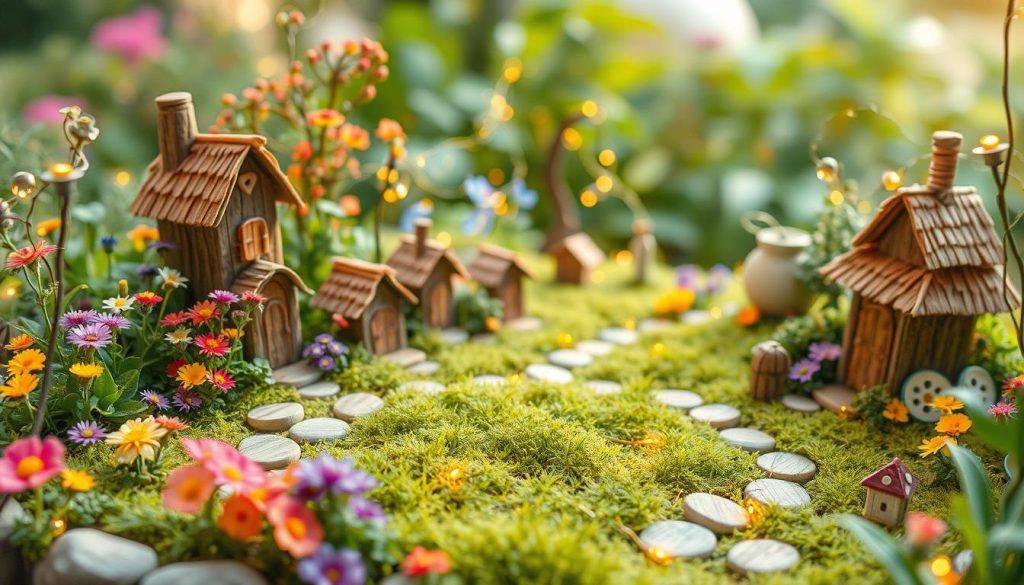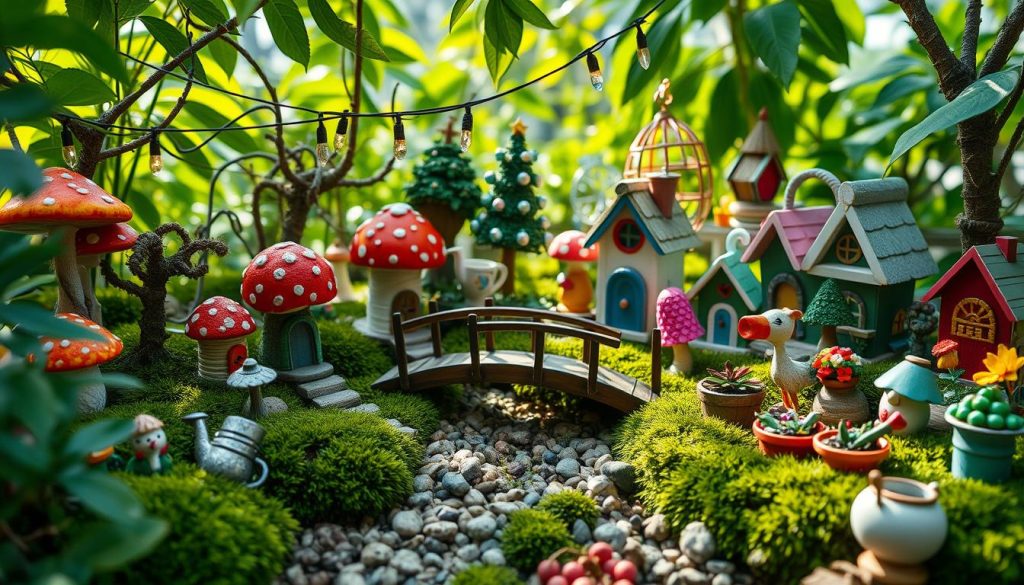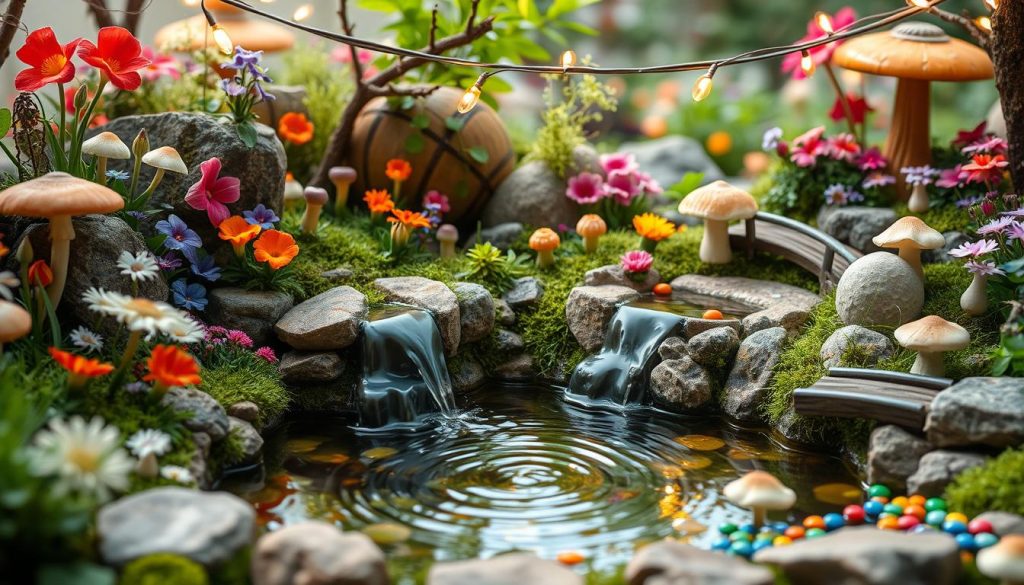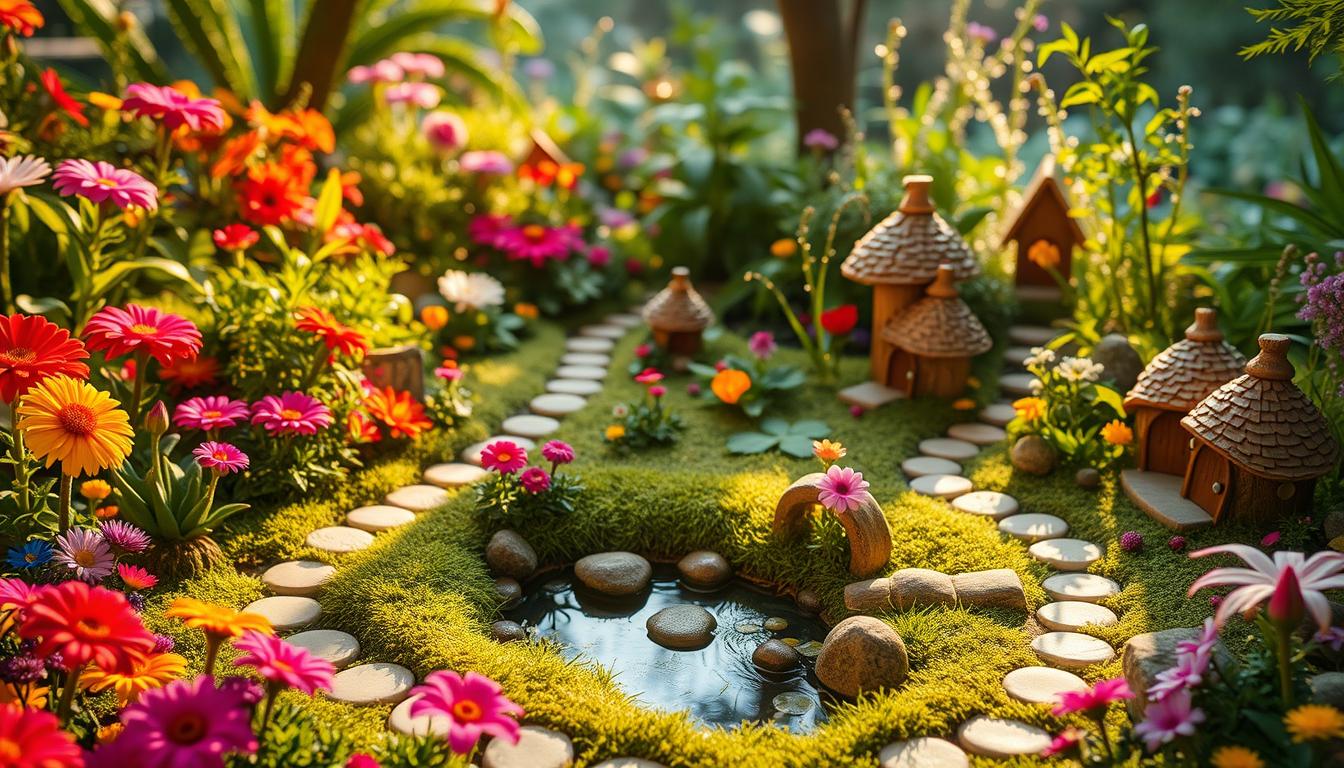Welcome to the enchanting world of fairy gardens! I’m excited to help you create your own miniature wonderland. Whether you’re a seasoned gardener or just starting, making a fairy garden is a fun adventure. It sparks creativity and adds magic to your home.
Fairy gardens are tiny landscapes filled with whimsical elements. They captivate the imagination. As we explore fairy garden ideas, you’ll find joy in designing these small marvels. From picking the right plants to arranging tiny accessories, every step lets you show your unique style.
Get ready for a magical journey where your creativity has no limits. Let’s explore the charming world of fairy gardens and add enchantment to your space!
What Is a Fairy Garden?
Fairy gardening is a mix of imagination and tiny landscaping. It’s a world of whimsy and wonder. These tiny gardens bring joy to everyone, young and old.
Definition and Origins
A fairy garden is a small garden that attracts fairies. It has tiny plants, small structures, and detailed accessories. This idea started in the Victorian era, when people believed in fairies.
Now, fairy gardening is a fun hobby. It combines creativity with growing plants.
Popular Fairy Garden Themes
I’ve seen many fairy garden themes, each unique. Some favorites include:
- Woodland: With moss, ferns, and tiny toadstools
- Beach: With miniature shells and driftwood
- Cottage: Featuring a tiny house and picket fence
- Seasonal: With decorations that change with the seasons
Fairy gardening is very flexible. I can make a magical garden in any space. It shows off my style and brings happiness to all who see it.
Choosing a Location for My Fairy Garden
Finding the perfect spot for my fairy garden is essential. I must think about both indoor and outdoor options. Each has its own benefits, and where I place it will shape my design.
Sunlight Requirements
Knowing what plants need is crucial for my garden’s health. Most plants do well with 4-6 hours of sunlight a day. I’ll check the light in different spots at home or in the yard.
Accessibility and Visibility
I want to enjoy my fairy garden often. So, I’ll choose a spot that’s easy to see and reach. A kitchen windowsill, patio table, or garden corner are great options.
The type of containers I use also matters. Lightweight plastic pots are easy to move, while heavier ceramic ones are better for fixed spots.
| Location | Pros | Cons |
|---|---|---|
| Indoor Windowsill | Protected from weather, easy to maintain | Limited space, may need grow lights |
| Outdoor Patio | Natural sunlight, more space for design | Exposed to elements, seasonal changes |
| Garden Nook | Blends with existing landscape, natural setting | Harder to protect from pests, less visible |
By considering these factors, I can create a thriving fairy garden. It will bring joy and magic to my space. Whether indoors or outdoors, the right spot will help my miniature world flourish.
Essential Supplies for Fairy Gardening
I love creating fairy gardens! They’re magical miniature worlds that spark joy and imagination. To start my enchanting project, I need the right fairy garden supplies. Let’s explore the essentials needed to bring these whimsical spaces to life.
Containers and Soil Options
Choosing the perfect container is crucial. I often use traditional pots, but sometimes I get creative with teacups or old wheelbarrows. For soil, I mix potting soil with sand and perlite to ensure good drainage. This helps my tiny plants thrive in their new home.
Miniature Decorations and Accessories
Fairy garden accessories are what truly bring these mini worlds to life. I adore adding tiny furniture, like miniature benches and tables. Small houses, bridges, and even fairy figurines add charm and personality to the garden.
Plants to Incorporate
Selecting the right plants is key. I choose slow-growing or naturally small plants to maintain the scale of my fairy garden. Here are some of my favorites:
| Plant Name | Characteristics | Care Level |
|---|---|---|
| Moss | Soft, carpet-like ground cover | Low |
| Miniature Ferns | Delicate, lacy foliage | Medium |
| Thyme | Fragrant, low-growing herb | Low |
| Baby’s Tears | Tiny, round leaves | Medium |
With these fairy garden supplies and accessories, I’m ready to create a magical miniature world. The fun part is mixing and matching elements to craft a unique, enchanting space that reflects my imagination.
Designing My Fairy Garden Space
Creating a fairy garden is a magical experience. I love planning the layout and bringing my fairy garden ideas to life. Let’s dive into the enchanting world of fairy garden design!
Layout Planning
When I start planning my fairy garden layout, I think about scale and proportion. I imagine tiny fairies exploring the space and ensure everything fits their size. I sketch my ideas on paper first, playing with different arrangements until I find the perfect design.

Creating Different Zones
I love creating distinct areas in my fairy garden. A cozy fairy dwelling, a miniature forest, and a tiny vegetable patch are some of my favorite zones. This variety adds depth and interest to the overall fairy garden design.
| Zone | Elements | Purpose |
|---|---|---|
| Fairy Dwelling | Tiny house, furniture | Focal point |
| Miniature Forest | Small trees, moss | Natural backdrop |
| Vegetable Patch | Tiny pots, miniature plants | Whimsical detail |
Balance in Design Elements
Achieving balance is key in fairy garden design. I mix textures, colors, and shapes to create a harmonious landscape. Placing taller elements at the back and shorter ones in front helps create depth. Remember, the goal is to craft a magical world that sparks imagination and brings joy!
Selecting the Right Plants
Choosing the perfect fairy garden plants is key to creating a magical miniature world. I’ve learned that the right selection can bring my fairy garden to life and make it a joy to maintain.
Best Plant Choices for Fairy Gardens
When I create a fairy garden, I focus on plants that stay small and compact. Some of my favorites include:
- Miniature ferns
- Irish moss
- Dwarf conifers
- Baby’s tears
- Creeping thyme
These fairy garden plants not only look adorable but also thrive in small spaces.
Seasonal Considerations
To keep my fairy garden looking fresh year-round, I plan for different seasons. In spring, I add tiny flowering bulbs. For summer, I include drought-tolerant succulents. Fall brings miniature ornamental grasses, while winter is perfect for evergreen groundcovers.
Maintenance Tips
Caring for fairy garden plants is crucial. I water gently with a spray bottle to avoid disturbing the miniature landscape. Pruning keeps plants in scale, and I use a small pair of scissors for precision. Regular fertilizing with a diluted liquid fertilizer helps maintain healthy growth without overpowering the delicate ecosystem.
| Season | Plant Suggestions | Care Tips |
|---|---|---|
| Spring | Miniature daffodils, Creeping phlox | Light fertilizing, Regular watering |
| Summer | Sedum, Dwarf mondo grass | Mulching, Shade protection |
| Fall | Miniature chrysanthemums, Dwarf asters | Less watering, Leaf cleanup |
| Winter | Miniature conifers, Wintergreen | Frost protection, Minimal watering |
Adding Fairy Garden Accessories
I love adding accessories to my fairy garden. These small details make a big difference. They turn a simple garden into a magical world. Let’s look at some popular miniatures and compare DIY and store-bought options.
Popular Miniatures to Use
Fairy garden accessories come in many shapes and sizes. I often start with a fairy house as the centerpiece. These can be rustic cottages or whimsical mushroom homes. Other favorites include:
- Miniature furniture (tables, chairs, benches)
- Tiny garden tools
- Fairy figurines
- Miniature animals
- Tiny lanterns or lights

DIY Accessories vs. Store-bought
I like mixing DIY and store-bought accessories. Making my own adds a personal touch and saves money. For example, I’ve made fairy doors from popsicle sticks and acorn cap birdbaths.
Store-bought items offer convenience and detail. The best approach is to combine both for a unique garden. When choosing a fairy house, I think about how it fits with my garden’s theme and scale. Whether handmade or bought, these miniature homes are the heart of my magical garden.
Creating a Fairy Pathway
I love adding enchanting pathways to my fairy garden ideas. These tiny trails bring life and movement to my miniature garden. They guide visitors through the magical landscape. Let’s explore how to create charming paths that will delight both fairies and humans alike.
Materials for Pathways
When choosing materials for my fairy garden paths, I consider both aesthetics and practicality. Here are some options I’ve found work well:
- Pebbles and gravel
- Crushed shells
- Miniature bricks or tiles
- Broken pottery pieces
- Wood slices
I like mixing different materials to create interesting textures and patterns. For example, I might use pebbles for the main path and wood slices for stepping stones.
Layout Ideas for Pathways
The layout of my fairy garden pathway can greatly impact the overall design. I enjoy experimenting with various patterns:
| Path Type | Description | Best For |
|---|---|---|
| Winding | Curves gently through the garden | Creating mystery and exploration |
| Straight | Direct path from one point to another | Formal or geometric designs |
| Stepping stones | Spaced stones or flat objects | Adding whimsy and playfulness |
| Bridges | Tiny spans over “water” features | Creating depth and interest |
I find that combining different path types adds variety and interest to my miniature garden. A winding main path with stepping stone offshoots can create a sense of adventure and discovery for tiny fairy visitors.
Incorporating Water Features
I love adding water features to my fairy garden design. They bring life and movement to my miniature world. Water features create a focal point and add whimsy.
Types of Water Features
There are many water feature options for fairy gardens. I often use tiny ponds from small dishes or bowls. Miniature fountains are another favorite, creating a soothing sound.
For a dramatic effect, I sometimes include a small waterfall. I use pebbles and a pump for this.

Placement and Design
When placing water features, I think about the garden’s layout. I aim for a natural setting, using small plants and rocks around the water. For larger gardens, I design a stream that winds through different areas.
In smaller spaces, a centrally placed pond works well. It becomes a gathering spot for fairies.
Maintenance is crucial for real water features. I clean them regularly and keep the water fresh. For easier upkeep, I sometimes use faux water made from clear resin. This gives the illusion of water without the need for frequent care.
By thoughtfully incorporating water features, I enhance my fairy garden’s magic and charm. These elements add depth and interest, making my fairy gardening experience enchanting.
Attracting Fairies to My Garden
I love adding magic to my fairy garden plants. To attract these magical creatures, we need to create the perfect environment. Let’s look at some ideas to make our gardens irresistible to fairies.
Fairy-Friendly Plants and Flowers
Fairies are attracted to certain plants and flowers. I’ve found that adding these to my garden makes it enchanting:
- Bluebells
- Foxgloves
- Primroses
- Thyme
- Lavender
These plants not only look great but also smell wonderful. I arrange them in small groups to create cozy spots for fairies.
Creating a Welcoming Atmosphere
To make my garden welcoming, I focus on a few key things:
- Tiny furniture: Miniature benches and tables make fairies feel at home
- Twinkling lights: Small LED lights create a magical glow at night
- Water features: A small fountain or birdbath adds a soothing sound
- Bells and chimes: Gentle tinkling sounds attract curious fairies
I also leave little gifts for the fairies, like acorn caps filled with honey or tiny plates of berries. These thoughtful touches make my garden a special place for both fairies and humans.
| Fairy Garden Element | Purpose | Examples |
|---|---|---|
| Plants | Attract and shelter fairies | Bluebells, Foxgloves, Thyme |
| Accessories | Create a fairy-sized world | Miniature furniture, Tiny houses |
| Sensory Elements | Enhance magical atmosphere | Chimes, Lights, Water features |
Seasonal Decor for My Fairy Garden
I enjoy making my fairy garden fresh and exciting all year. By changing the decor with the seasons, I create a magical world that’s always new. Let’s look at some enchanting ideas for winter and summer themes in fairy gardening.
Winter Wonderland Theme
In winter, I turn my fairy garden into a tiny winter wonderland. I use tiny pine trees covered in artificial snow and add miniature ice skaters to a mirror “pond.” Tiny fairy lights wrapped around twigs make it cozy.

Summer Blooms and Vibrant Colors
In summer, I change the decor to bright, colorful elements. I plant miniature sunflowers and daisies for a cheerful look. Tiny fairy figurines peek out from behind brightly colored toadstools.
I add a miniature picnic set and a tiny clothesline with fairy-sized garments for a whimsical touch.
To keep my fairy garden interesting all year, I rotate plants and accessories seasonally. This keeps the magic alive and lets me show off my creativity with fairy gardening. Whether it’s a snowy scene or a summer paradise, my fairy garden always tells a captivating story.
Caring for My Fairy Garden
Keeping my fairy garden looking its best is very important. I’ve learned that taking good care of it is key. Here are some important tips for keeping it enchanting.
Watering and Feeding
I water my fairy garden with care, using a small can or mister. This method helps prevent soil from washing away and keeps plants safe. Most tiny plants like the soil a bit moist but not too wet.
For feeding, I use a weak liquid fertilizer once a month when plants are growing.
Pest Control and Protection
It’s important to protect my fairy garden from pests. I use natural ways to keep it pest-free. Here’s a simple guide I follow:
| Pest | Control Method |
|---|---|
| Aphids | Spray with soapy water |
| Slugs | Sprinkle diatomaceous earth around plants |
| Fungal diseases | Improve air circulation, avoid overwatering |
To keep my fairy garden safe from bad weather, I use tiny cloches or move it inside when it’s too cold or hot. With these care tips and the right supplies, my fairy garden stays magical all year.
Showcasing My Fairy Garden
I love sharing my fairy garden ideas with others. It’s a great way to spread the magic and inspire more people to create their own miniature worlds. Let me tell you how I make my fairy garden shine in photos and bring joy to my friends and family.
Photography Tips
Capturing the charm of a fairy house can be tricky, but I’ve learned some tricks. I use natural light early in the morning or during the golden hour for the best results. Getting down to fairy level helps me frame the shot perfectly. I focus on small details, like tiny flower pots or fairy doors, to bring out the magic in my pictures.
Sharing with Friends and Family
My fairy garden has become a hit with my loved ones. I invite them over for mini tea parties, where we sip from tiny cups and imagine fairies flitting about. For birthdays, I craft fairy garden-themed gifts, like small potted plants with miniature decorations. It’s a fun way to spread the enchantment and get others excited about creating their own fairy gardens.
Remember, fairy gardens aren’t just for show. They’re little pockets of wonder that bring smiles to everyone who sees them. Whether you’re snapping photos or hosting a fairy tea party, sharing your creation spreads joy and keeps the magic alive.

